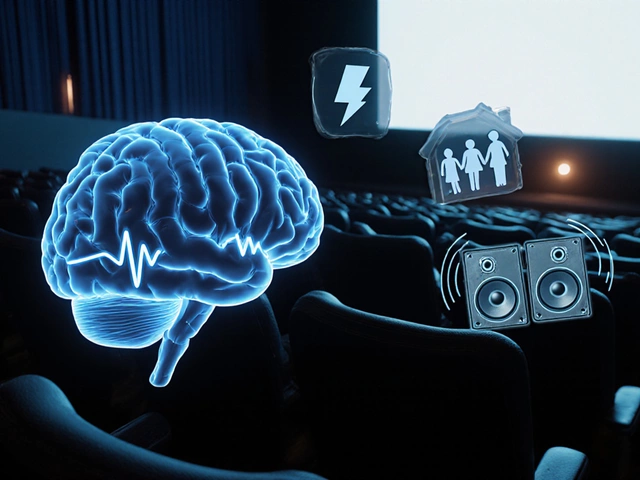
Suspense Element Analyzer
Analyze your story's suspense potential using the three pillars of suspense from the article. Select which elements are present and rate their intensity to get your personalized suspense score.
Select Your Suspense Elements
Suspense Score
How Suspense Works
Your score is calculated based on the three pillars from the article:
Time Pressure (countdowns), High Stakes (personal consequences), and Uncertainty (trust issues).
- 8-10: High suspense potential - like The Girl on the Train
- 5-7: Solid suspense - typical thriller
- 1-4: Low suspense - more mystery than thriller
Ever read a book where every page made your heart race, your palms got sweaty, and you kept glancing over your shoulder even though you were alone in a quiet room? That’s the power of a suspenseful thriller. It’s not just about violence or twists-it’s about the slow, unbearable tension that builds until you can’t turn the pages fast enough.
It’s Not Just About the Crime
A suspenseful thriller doesn’t start with a body. It starts with a question. Who took her? Why did he leave the door unlocked? What’s in the envelope no one’s supposed to open? The crime is the hook, but the suspense is what keeps you hooked. Unlike a detective story where the focus is on solving the puzzle, a suspenseful thriller makes you feel the weight of what might happen next.Think of The Girl on the Train by Paula Hawkins. The murder isn’t even the main event for most of the book. It’s the uncertainty. The unreliable narrator. The way every glance, every text message, every silence feels like a threat. That’s the hallmark of this genre: the danger isn’t always visible. It’s in the air.
The Three Pillars of Suspense
There are three things every great suspenseful thriller has in common. Get these right, and the reader won’t put the book down.- Time pressure - The clock is always ticking. A bomb is set to go off in 48 hours. The child will be gone by sunrise. The witness won’t survive the night. Deadlines create urgency. Without them, tension fades.
- High stakes - It’s not just about catching a killer. It’s about saving a family, protecting an innocent, or stopping a conspiracy that could collapse a city. The cost of failure has to feel real, personal, and devastating.
- Uncertainty - Who can you trust? Is the detective hiding something? Is the husband lying? Is the therapist helping-or manipulating? The reader needs to doubt everyone, including themselves.
These aren’t optional. Skip one, and the thriller loses its grip. Skip two, and it becomes just another crime novel.
How It Differs From Other Thrillers
Not all thrillers are suspenseful. There’s a big difference between a fast-paced action thriller like Jack Reacher and a slow-burn suspense thriller like Sharp Objects by Gillian Flynn.Action thrillers rely on chases, fights, explosions. They’re loud. Suspenseful thrillers are quiet. They’re the creak on the stairs. The flickering light. The phone ringing at 3 a.m. They don’t need guns to scare you. They use silence.
Psychological thrillers often overlap with suspenseful ones, but they dig deeper into the mind. Think of The Silent Patient by Alex Michaelides. The crime is solved early. The suspense comes from wondering if the protagonist is guilty-or if the world around him is unraveling.

Real-World Suspense: Why It Feels So Real
The best suspenseful thrillers borrow from real fears. Not monsters or aliens. Things that could actually happen.- Being watched by someone you don’t know
- Someone lying to you about something small, then something big
- Discovering your partner’s secrets
- Missing a child in a crowded place
- Receiving a message that shouldn’t exist
Authors like Tana French and Harlan Coben build entire novels around these everyday horrors. They don’t need serial killers with elaborate masks. They just need a neighbor who smiles too much, a text that says “I know what you did,” or a photo that wasn’t taken by anyone in the room.
The Role of the Unreliable Narrator
One of the most powerful tools in a suspenseful thriller is the unreliable narrator. Not because they’re lying on purpose-but because they don’t know the truth themselves.In Behind Closed Doors by B.A. Paris, the main character tells you she’s safe. But the way she describes her husband’s routines, the way she flinches at certain words, the way she avoids mirrors… you start to question everything. Is she a victim? Or is she hiding something darker?
This technique works because it mirrors real life. We all filter our stories. We lie to protect ourselves. We forget things. We convince ourselves of things that aren’t true. A great suspenseful thriller makes you feel that same confusion.

Setting as a Character
Location isn’t just backdrop in a suspenseful thriller. It’s a weapon.A remote cabin. A crumbling apartment building. A small town where everyone knows your name-and your secrets. These places aren’t neutral. They trap you. They isolate you. They whisper.
In The Dry by Jane Harper, the Australian drought isn’t just weather. It’s a character. It’s the reason people are desperate. The reason secrets are buried. The reason no one dares to ask questions. The heat, the dust, the silence-they all add pressure. Like a noose tightening.
What Makes a Suspenseful Thriller Last
Some thrillers are page-turners. Others stick with you for years.The ones that last don’t just surprise you. They haunt you. They make you look at your own life differently. You start checking the locks. You second-guess a friend’s smile. You wonder if you’ve missed the signs.
That’s the mark of a true suspenseful thriller. It doesn’t end when you close the book. It lingers. It changes how you see the world.
That’s why people keep coming back to it. Not for the violence. Not for the twists. But for the feeling that something terrible could happen at any moment-and you’re the only one who knows it’s coming.
Is a suspenseful thriller the same as a horror story?
No. Horror aims to scare you with supernatural threats, gore, or the unknown. A suspenseful thriller scares you with what’s real-human behavior, secrets, and the fear of what might happen next. You won’t find ghosts in a true suspenseful thriller. You’ll find a neighbor who’s too helpful, a spouse who won’t answer your calls, or a file that disappeared from your computer.
Can a suspenseful thriller have a happy ending?
Yes, but it’s rare-and it has to feel earned. A happy ending in a suspenseful thriller doesn’t mean everything is fixed. It means the threat is contained, the truth is out, and the protagonist survives with scars. Think of Sharp Objects-the killer is caught, but the main character is left broken. That’s not a happy ending in the traditional sense. It’s a survival ending. And that’s more powerful.
What’s the difference between a thriller and a mystery?
A mystery asks: Who did it? A suspenseful thriller asks: What will happen next? In a mystery, the reader follows the detective as clues are uncovered. In a suspenseful thriller, the reader is often one step behind the danger, feeling the tension build as the threat closes in. The focus isn’t on solving the puzzle-it’s on surviving it.
Do I need to read other thrillers to enjoy a suspenseful one?
No. Suspenseful thrillers work because they tap into universal fears-loss, betrayal, isolation, helplessness. You don’t need to have read Gone Girl to feel the dread in The Woman in the Window. What matters is how well the story builds tension, not how familiar you are with the genre.
Why do people love suspenseful thrillers so much?
Because they give you control in a world that feels out of control. Reading one lets you experience fear in a safe space. You know you can close the book. You know the worst won’t happen to you. But for those few hours, you’re on the edge of your seat, feeling alive. That’s why people binge them. It’s not just entertainment-it’s emotional adrenaline.
Where to Start If You’re New to the Genre
If you’ve never read a suspenseful thriller before, start with books that balance tension with strong characters:- The Girl on the Train by Paula Hawkins - Unreliable narrator, everyday dread, perfect pacing.
- The Dry by Jane Harper - Small-town secrets, oppressive setting, slow-burn tension.
- Big Little Lies by Liane Moriarty - Domestic suspense with layered characters and hidden violence.
- Behind Closed Doors by B.A. Paris - Psychological control, chilling realism, impossible to put down.
These aren’t just thrillers. They’re experiences. And once you’ve felt that kind of suspense, you’ll always be looking for the next one.


